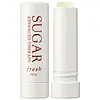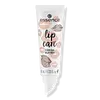What's inside
What's inside
 Key Ingredients
Key Ingredients

 Benefits
Benefits

 Concerns
Concerns

 Ingredients Side-by-side
Ingredients Side-by-side

Cera Alba
EmollientSimmondsia Chinensis Seed Oil
EmollientHydrogenated Olive Oil Decyl Esters
Emulsion StabilisingHydrogenated Palm Kernel Glycerides
EmollientRicinus Communis Seed Oil
MaskingVitis Vinifera Seed Oil
EmollientEthylhexyl Palmitate
EmollientParfum
MaskingHydrogenated Palm Glycerides
EmollientTheobroma Grandiflorum Seed Butter
Skin ConditioningPrunus Domestica Seed Oil
Skin ConditioningCopernicia Cerifera Wax
Limnanthes Alba Seed Oil
Skin ConditioningHydrogenated Vegetable Oil
EmollientPassiflora Incarnata Seed Oil
Skin ProtectingSucrose Tetrastearate Triacetate
EmollientCrithmum Maritimum Extract
Skin ConditioningCommiphora Mukul Resin Extract
Skin ConditioningRibes Nigrum Seed Oil
EmollientTocopherol
AntioxidantAscorbyl Tetraisopalmitate
AntioxidantTocopheryl Acetate
AntioxidantAscorbyl Palmitate
AntioxidantPEG-6 Isostearate
EmulsifyingCaprylic/Capric Triglyceride
MaskingAmmonium Glycyrrhizate
MaskingTrihydroxystearin
Skin ConditioningHesperetin Laurate
AntioxidantVanillin
MaskingButylene Glycol
HumectantBHT
AntioxidantCaprylyl Glycol
EmollientSodium Hyaluronate
HumectantHexylene Glycol
EmulsifyingPhenoxyethanol
PreservativeLimonene
PerfumingCitral
PerfumingBenzyl Alcohol
PerfumingLinalool
PerfumingGeraniol
PerfumingCera Alba, Simmondsia Chinensis Seed Oil, Hydrogenated Olive Oil Decyl Esters, Hydrogenated Palm Kernel Glycerides, Ricinus Communis Seed Oil, Vitis Vinifera Seed Oil, Ethylhexyl Palmitate, Parfum, Hydrogenated Palm Glycerides, Theobroma Grandiflorum Seed Butter, Prunus Domestica Seed Oil, Copernicia Cerifera Wax, Limnanthes Alba Seed Oil, Hydrogenated Vegetable Oil, Passiflora Incarnata Seed Oil, Sucrose Tetrastearate Triacetate, Crithmum Maritimum Extract, Commiphora Mukul Resin Extract, Ribes Nigrum Seed Oil, Tocopherol, Ascorbyl Tetraisopalmitate, Tocopheryl Acetate, Ascorbyl Palmitate, PEG-6 Isostearate, Caprylic/Capric Triglyceride, Ammonium Glycyrrhizate, Trihydroxystearin, Hesperetin Laurate, Vanillin, Butylene Glycol, BHT, Caprylyl Glycol, Sodium Hyaluronate, Hexylene Glycol, Phenoxyethanol, Limonene, Citral, Benzyl Alcohol, Linalool, Geraniol
Caprylic/Capric Triglyceride
MaskingBis-Diglyceryl Polyacyladipate-2
EmollientButyrospermum Parkii Butter
Skin ConditioningPentaerythrityl Tetraisostearate
EmollientTheobroma Cacao Seed Butter
EmollientGlyceryl Behenate
EmollientHelianthus Annuus Seed Wax
Skin ConditioningHydrogenated Castor Oil Dimer Dilinoleate
Skin ConditioningTrihydroxystearin
Skin ConditioningGlyceryl Stearate
EmollientTocopheryl Acetate
AntioxidantHelianthus Annuus Seed Oil
EmollientTocopherol
AntioxidantEthyl Vanillin
MaskingEthylhexylglycerin
Skin ConditioningAscorbyl Palmitate
AntioxidantBeta-Sitosterol
Emulsion StabilisingSqualene
EmollientPhenoxyethanol
PreservativeAroma
Caprylic/Capric Triglyceride, Bis-Diglyceryl Polyacyladipate-2, Butyrospermum Parkii Butter, Pentaerythrityl Tetraisostearate, Theobroma Cacao Seed Butter, Glyceryl Behenate, Helianthus Annuus Seed Wax, Hydrogenated Castor Oil Dimer Dilinoleate, Trihydroxystearin, Glyceryl Stearate, Tocopheryl Acetate, Helianthus Annuus Seed Oil, Tocopherol, Ethyl Vanillin, Ethylhexylglycerin, Ascorbyl Palmitate, Beta-Sitosterol, Squalene, Phenoxyethanol, Aroma
Alternatives
Ingredients Explained
These ingredients are found in both products.
Ingredients higher up in an ingredient list are typically present in a larger amount.
Ascorbyl Palmitate is created by combining pure Vitamin C and palmitic acid. It is an antioxidant and helps reduce hyperpigmentation.
This ingredient is a more stable version of Vitamin C, meaning it does not disintegrate as quickly when exposed to sunlight. However, studies show it does not penetrate skin as well as pure Vitamin C.
Ascorbyl Palmitate is oil soluble.
Read more about other types of Vitamin C:
Learn more about Ascorbyl PalmitateThis ingredient is an emollient, solvent, and texture enhancer. It is considered a skin-softener by helping the skin prevent moisture loss.
It helps thicken a product's formula and makes it easier to spread by dissolving clumping compounds.
Caprylic Triglyceride is made by combining glycerin with coconut oil, forming a clear liquid.
While there is an assumption Caprylic Triglyceride can clog pores due to it being derived from coconut oil, there is no research supporting this.
Learn more about Caprylic/Capric TriglyceridePhenoxyethanol is a preservative that has germicide, antimicrobial, and aromatic properties. Studies show that phenoxyethanol can prevent microbial growth. By itself, it has a scent that is similar to that of a rose.
It's often used in formulations along with Caprylyl Glycol to preserve the shelf life of products.
Tocopherol (also known as Vitamin E) is a common antioxidant used to help protect the skin from free-radicals and strengthen the skin barrier. It's also fat soluble - this means our skin is great at absorbing it.
Vitamin E also helps keep your natural skin lipids healthy. Your lipid skin barrier naturally consists of lipids, ceramides, and fatty acids. Vitamin E offers extra protection for your skin’s lipid barrier, keeping your skin healthy and nourished.
Another benefit is a bit of UV protection. Vitamin E helps reduce the damage caused by UVB rays. (It should not replace your sunscreen). Combining it with Vitamin C can decrease sunburned cells and hyperpigmentation after UV exposure.
You might have noticed Vitamin E + C often paired together. This is because it is great at stabilizing Vitamin C. Using the two together helps increase the effectiveness of both ingredients.
There are often claims that Vitamin E can reduce/prevent scarring, but these claims haven't been confirmed by scientific research.
Learn more about TocopherolTocopheryl Acetate is AKA Vitamin E. It is an antioxidant and protects your skin from free radicals. Free radicals damage the skin by breaking down collagen.
One study found using Tocopheryl Acetate with Vitamin C decreased the number of sunburned cells.
Tocopheryl Acetate is commonly found in both skincare and dietary supplements.
Learn more about Tocopheryl AcetateThis ingredient comes from Hydroxystearic Acid, a fatty acid, and glycerin. It is used to thicken oils.
Due to its fatty acid content, it is a natural emollient.
Creating trihydroxystearin involves using a chemical reaction between hydrogen and castor oil.
This ingredient may not be Malassezia folliculitis safe.
Learn more about Trihydroxystearin